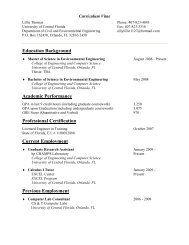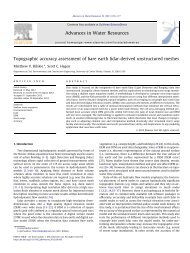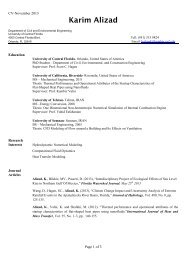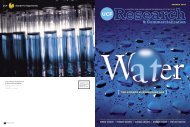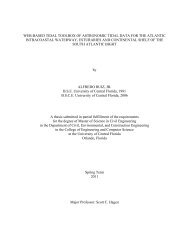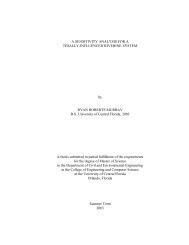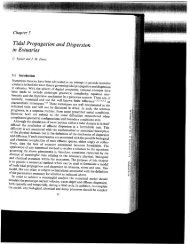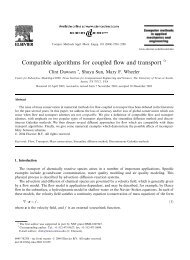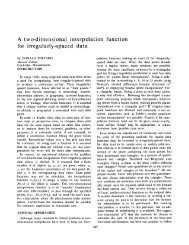Deriving Frictional Parameters and Performing Historical Validation ...
Deriving Frictional Parameters and Performing Historical Validation ...
Deriving Frictional Parameters and Performing Historical Validation ...
You also want an ePaper? Increase the reach of your titles
YUMPU automatically turns print PDFs into web optimized ePapers that Google loves.
THE FLORIDA WATERSHED JOURNAL 27<br />
<strong>and</strong> simulated surge levels at gauge locations 572, 8728690, <strong>and</strong><br />
8727520. Overall the comparison between model <strong>and</strong> historic data<br />
appears reasonable. Modeled results compare very well with gauge<br />
hydrographs while maximum difference in HWMs range from 1 to 2<br />
ft with the model results biased lower which seems typical <strong>and</strong> expected<br />
based on the known physical <strong>and</strong> limitations of the modeling.<br />
Summary<br />
As part of the development of a storm surge model for use by FEMA<br />
in updating DFIRMs within Wakulla, Jefferson, <strong>and</strong> Franklin counties<br />
Florida, inputs for the ADCIRC model have been developed to<br />
account for the surface characteristics of the region. Nodal values<br />
of Manning’s-n, anisotropic wind shielding, <strong>and</strong> vegetative canopy<br />
have been derived from available l<strong>and</strong>-cover datasets. The resulting<br />
model has been used to hindcast several historic hurricanes. The<br />
validation results compare well to the available data.<br />
References<br />
• Arcement, G.J., <strong>and</strong> V.R. Schneider. 1989. “Guide for Selecting<br />
Manning's Roughness Coefficients for Natural Channels <strong>and</strong> Flood<br />
Plains”, U.S. Geological Survey Water-Supply Paper 2339, U.S.<br />
Geological Survey, Denver, Colorado.<br />
• Barnes, H.H. 1967. “Roughness Characteristics of Natural<br />
Channels,” U.S. Geological Survey Water-Supply Paper 1849, U.S.<br />
Geological Survey, Washington D.C.<br />
• Cardone, V.J., C.V. Greenwood, <strong>and</strong> J.A. Greenwood. 1992.<br />
“Unified program for the specification of hurricane boundary layer<br />
winds over surfaces of specified roughness.” Contract Report<br />
CERC-92-1, U.S. Army Corps of Engineers. Available at: ERDC<br />
Vicksburg (WES), U.S. Army Engineer Waterways Experiment<br />
Station (WES), ATTN: ERDC-ITL-K, 3909 Halls Ferry Road,<br />
Vicksburg, Mississippi, 39180-6199.<br />
• Charnock, H. 1955. “Wind stress on a water surface.” Quart. J.<br />
Royal Met. Society, 81: 639-640.<br />
• Chow, V.T. 1959. Open Channel Hydraulics, McGraw-Hill Book<br />
Company, New York.<br />
• Federal Emergency Management Agency. 2005. “HAZUS: Hazard loss<br />
estimation methodology.” http://www.fema. gov/hazus/index.shtm.<br />
• Feyen, J.C., J.H. Atkinson, <strong>and</strong> J.J. Westerink. 2000. “Issues in<br />
hurricane surge computations using a GWCE-based finite element<br />
model.” Proc., XIII Conf. on Computational Methods in Water<br />
Resources, Vol. II, L. Bentley, J. Sykes, C. Brebbia, W. Gray, <strong>and</strong> G.<br />
Pinder, Eds., 865-872.<br />
• Garratt, J.R., Review of drag coefficients over oceans <strong>and</strong> continents,<br />
Monthly Weather Review, V105, 1977, 915-929.<br />
• Hagen , S.C. , A. Zundel <strong>and</strong> S. Kojima, "Automatic, Unstructured Mesh<br />
Generation for Tidal Calculations in a Large Domain." International<br />
Journal of Computational Fluid Dynamics, 20(8), 593-608 (2006).<br />
• Hagen, S. C., Westerink, J. J., Kolar, R. L., <strong>and</strong> Horstmann, O., "Twodimensional,<br />
unstructured mesh generation for tidal models."<br />
International Journal for Numerical Methods in Fluids, 35, 669-686<br />
(2001).<br />
• Ho, F.P., <strong>and</strong> V.A. Myers. 1975. “ Joint Probability Method of Tide<br />
Frequency Analysis applied to Apalachicola Bay <strong>and</strong> St. George<br />
Sound, Florida,” NOAA Technical Report NWS 18, 43p.<br />
• Hsu, S.A., Coastal Meteorology, Academic Press, 1988.<br />
• Le Provost, C., F. Lyard, J. Molines, M. Genco, <strong>and</strong> F. Rabilloud, A<br />
hydrodynamic ocean tide model improved by assimilating a satellite<br />
altimeter-derived data set. Journal of Geophysical Research, v103,<br />
5513-5529, 1998.<br />
• Mukai, A., J.J. Westerink, R.A. Luettich, <strong>and</strong> D. Mark. 2001b. “A<br />
Tidal Constituent Database for the Western North Atlantic Ocean,<br />
Gulf of Mexico <strong>and</strong> Caribbean Sea,” Technical Report, U.S. Army<br />
Engineer Research <strong>and</strong> Development Center.<br />
• Mukai, A., J.J. Westerink, R.A. Luettich, <strong>and</strong> D. Mark. 2002. “Eastcoast<br />
2001: a tidal constituent database for the Western North Atlantic, Gulf<br />
of Mexico <strong>and</strong> Caribbean Sea,” U.S. Army Corps of Engineers Research<br />
<strong>and</strong> Development Center, Coastal <strong>and</strong> Hydraulics Laboratory,<br />
Technical Report, ERDC/CHL TR-02-24. 201p. September.<br />
• National Geodetic Survey: Vertical datums. http://www.ngs.noaa.gov/.<br />
• Parrish, D.M., <strong>and</strong> Hagen, S.C., "Incorporating Spatially Variable<br />
Bottom Stress <strong>and</strong> Coriolis Force into 2D, a posteriori, Unstructured<br />
Mesh Generation for Shallow Water Models." International Journal<br />
for Numerical Methods in Fluids, 60(3), 237-261 (30 May 2009).<br />
• Parrish, D.M., <strong>and</strong> Hagen, S.C., "2D, Unstructured Mesh Generation<br />
for Oceanic <strong>and</strong> Coastal Tidal Models from a Localized Truncation<br />
Error Analysis with Complex Derivatives." International Journal of<br />
Computational Fluid Dynamics, 21(7), 277-296 (2007).<br />
• Powell, M.D., S. Houston, <strong>and</strong> T. Reinhold, Hurricane Andrew’s<br />
l<strong>and</strong>fall in South Florida. Part I: St<strong>and</strong>ardizing measurements for<br />
documentation of surface wind fields. Weather Forecasting, v11,<br />
1996, 304-328.<br />
• Reid, R.O., <strong>and</strong> R. Whitaker. 1976. “Wind-driven flow of water<br />
influenced by a canopy.” J. Waterw., Harbors, Coastal Engr. Div.-<br />
Am. Soc. Civ. Eng., 102, WW1, 61-77.<br />
• Reid, R. O., <strong>and</strong> Whitaker, R. E. (1981). “Numerical model for<br />
astronomical tides in the Gulf of Mexico, I: Theory <strong>and</strong> application.”<br />
Technical Report, Department of Oceanography, Texas A&M<br />
University, College Station, Texas (prepared for U.S. Army Engineer<br />
Waterways Experiment Station, Vicksburg, Mississippi).<br />
• Wamsley, T.V., M. A. Cialone, J. M. Smith, J. H. Atkinson, J. D.<br />
Rosati, "The potential of wetl<strong>and</strong>s in reducing storm surge", Ocean<br />
Engineering, v37, 36-47, 2010.<br />
• Westerink, J.J., Blain, C.A., Luettich, R.A., <strong>and</strong> Scheffner, N.W.<br />
(1994). ADCIRC: An Advanced Three-Dimensional Circulation<br />
Model for Shelves, Coasts, <strong>and</strong> Estuaries Report No. 2. User’s<br />
Manual for ADCIRC-2DDI, Technical Report DRP-92-6, January<br />
1994, U.S. Army Engineer Waterways Experiment Station,<br />
Vicksburg, Mississippi.<br />
John Atkinson: john.atkinson@arcadis-us.com<br />
AN OFFICIAL PUBLICATION OF THE FWEA AND THE FLORIDA SECTION AWRA



